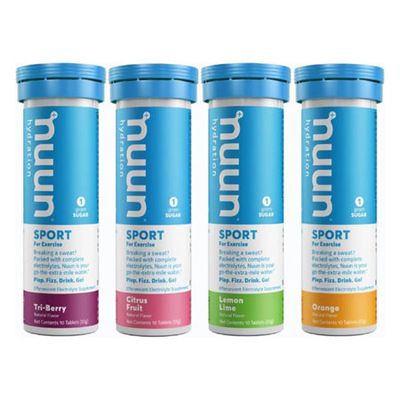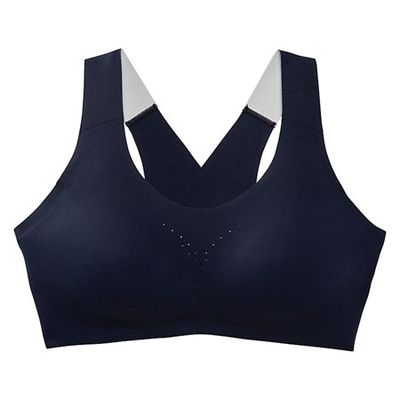
Are You Making One Of These Running Mistakes?
Skipping The Warm-Up
“A pre-run warm up is so important – in fact, the harder your session, the more important it is. People tend to treat a warm-up as either a couple of static stretches or just a light jog, both of which are sub-optimal. Most people forget that the muscles of the trunk play a massive role in our running and to get them fired up is a good idea. Ten seconds of side planks on each side, as well as a couple of ten second planks and a couple of ten second glute bridges is enough to get the muscles ready for action. Just remember too much flexibility before we run is counterproductive – remember you want to tune the guitar strings before you play, rather than loosen them.” – Anthony Fletcher, founder of Onetrack run club and biomechanics coach
Not Tuning Into Your Cycle
“Running while you are on your period is fine, sometimes better than fine – after all, Paula Radcliffe broke the marathon world record in 2002 after suffering period cramps in the last few miles. But the hormones which fluctuate across your cycle might affect how it feels when you run. For example, the high hormone levels in the second half of the cycle can mean we are better able to use fat for energy – this might make low intensity running feel easier as your body is set up to fuel this type of exercise. High oestrogen just before ovulation leaves some women feeling more energised, which may help motivation during a run. A rise in core body temperature in the second half of the cycle might make running on hot day feel harder. Every woman’s cycle is different, and the most important thing is to tune in to how you feel across your cycle and work with that to plan how and when you want to exercise.” – Dr. Emma Ross, head of physiology at the English Institute of Sport and founder of Thrive Revolution
Ignoring Form
“When you run, you should imagine you’re running over tiny hurdles on the floor, feeling your elbow swinging forwards and backwards. Keep your head high and avoid looking down for long periods of time – the faster you run, the more exaggerated the first two points become. Be wary about changing the way you run, however, as changing your technique can shift the load from one part of the body to another. Sometimes we might want to move forces away from an area due to irritation or injury to promote healing. However, if we are placing force onto areas that are not adapted to absorbing the workload, then we could cause injuries.” – Anthony
Failing To Eat Enough
“The biggest mistake people make is over-using fasted training sessions. Yes, there may be a time and benefit to doing them every so often, but we are seeing more and more evidence that suggests they don’t help with weight loss and can hinder performance, especially during tougher sessions. The same goes for hydration – always approach a session adequately hydrated. If you’re out there in ‘normal’ conditions and the session isn’t lasting more than an hour then there’s no need to drink additional water.” – Anthony
Starting Out Faster Than You Finish
“The idea behind negative splits (finishing faster than you started) is a great one, but it rarely happens. Studies show starting a little slower than your goal average pace seems to increase the chances of a faster finish, but nearly everyone slows down at some point towards the middle of a race and then picks up the pace for the finish, even the world record holders.” – Anthony
Going Too Far, Too Soon
“Everyone is different when it comes to workload – some people can handle big jumps in mileage while others can’t. Injuries are multi-factorial, and while mileage can play a part, it’s only a piece of the puzzle. My runners have a three-week build of between a 5-15% increase in mileage weekly and on the fourth week we drop the mileage down again. We cycle this way until we have reached our goal.” – Anthony
Wearing The Wrong Bra
“Did you know that running in a bra with poor support can shorten your stride by 4cm, adding up to running an additional mile over the course of a marathon? Around 80% of women are running in an incorrectly sized bra, and this is most commonly due to women underestimating their cup size and overestimating their band size. When determining the fit of your sports bra, you should ensure the bottom band is secure – it should sit level around the body without riding up at the back. As a general rule of thumb, you should be able to fit two fingers under the band, but not comfortably more than this. Next, you should look at the cup shape – there shouldn’t be any spilling at the neckline or armhole, as this is a sign the cups are too small. On the other hand, if the cups are gaping, that’s a sign the bra is too large. Lastly, your straps should be at a comfortable tension without digging in or sliding off.” – Helen Spalton, apparel merchandising manager at Brooks Running
Neglecting Recovery
“We should be giving a huge amount of attention to fitness recovery in general but especially if we’re running. The human mind is pre-wired to keep doing more (once we find something we enjoy) and so our first thought isn’t about doing less. People neglect all aspects of preventative health until it’s needed as a cure. Sleep is the only way we actually recover, everything else is there as an aid. Stress management would be next on the list.” – Anthony
Running The Same Route At The Same Speed
“We need variety to stress the body in different ways, however we also need familiarity in order for the body to adapt. Working in blocks seems to have a strong evidence base to it – i.e. focusing on a particular result that you want to achieve for a set period of time and then move on to the next adaption that you want to elicit. If we keep doing the same thing (speed, route, distance, etc.) then that can lead to a lack of progress but potentially an increased risk of injury too. Progress isn’t always gained by doing more or going faster – sometimes less and slower is the best route for some people. An ideal week would depend on what block you were in and will be different for everyone. The ideal week is where you feel successful and not drained.” – Anthony
Wearing The Wrong Trainers
“I’m still not convinced there are dramatic differences between a pair of shoes that cost £90 and a pair that’s £200, unless you are at an elite level running more than 100 miles a week and trying to break records. You should buy shoes that are designed for running though – so many people run in the wrong type of footwear rather than the wrong price tag. With regards to mileage, most shoes are designed to last between 300-500 miles, but this can fluctuate based on how light you are, how much you use them to walk around in casually and whether you do other training in them. It comes down to ‘hours worn’ more than miles run.” – Anthony
Trying To Run On The Balls Of Your Feet
“In short, it doesn’t matter what part of the foot you land on – it won’t make a difference to how good a runner you are. You’ll land differently if you change your shoes, the terrain you’re running on, the speed you’re running at and the time you’ve been running for. The main reason that most of the elite runners run towards the front of their foot is due to the speed they are running at.” – Anthony
Overthinking How You’re Breathing
“Some people believe how you breathe can affect your performance, but the evidence is lacking in this area. A few studies suggest breathing through the nose can have an affect oxygen usage, but this doesn’t seem to affect time to exhaustion, so it depends how you define performance. My personal philosophy is that we should work on how we think about our breathing (ideally using it to control the mind and feel less panicked) or slow down your running speed to reduce the amount of breathing you’re doing.” – Anthony
Forgetting Strength Training
“Strength training is incredibly important if there is time for it. With some pro athletes there just isn’t time or energy to fit it in but there is hot debate at the moment on if they should sacrifice an hour on the road for an hour in the gym – the thinking is this could help with consistency and injury risk. The truth is we could all benefit from a well-balanced strength programme, and you don’t need to go crazy to see results – just one or two sessions per week is plenty.” – Anthony
For more information or to book a session, visit OneTrack.Club. Brooks Running has just launched the Dare collection, designed with unique runner insights and breast movement research led by the University of Portsmouth; visit BrooksRunning.com.
Shop Our Edit Of Essential Kit Below...
DISCLAIMER* Features published by SheerLuxe are not intended to treat, diagnose, cure or prevent any disease. Always seek the advice of your GP or another qualified healthcare provider for any questions you have regarding a medical condition, and before undertaking any diet, exercise or other health-related programme.
DISCLAIMER: We endeavour to always credit the correct original source of every image we use. If you think a credit may be incorrect, please contact us at info@sheerluxe.com.





